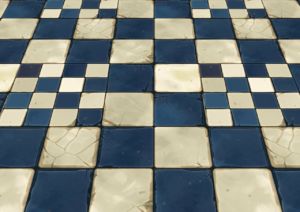Laying even, level tiles can be a challenging task for novices and professionals alike. Every floor is different, including the type of tile, layout, existing backing, and the condition of the substrate, among many other factors. We’re here to show you that while laying level floor tile can be time consuming, it’s completely doable without having to hire the professionals.
First Steps: Determining the Condition of your Substrate

While it may be tempting to eyeball a level surface, or just tile over any holes without filling them, you’ll only complicate the process. The more prep work you do, the better the installation will flow, and the better your finished product will look.
If your substrate is in good condition, it’s easy to determine whether the surface is level. Grab your level and slide it across the floor to locate uneven areas. Mark any uneven locations you find with a pencil.
Depending on your preference, you can pour self-levelling solution into any holes that might exist, taper the edges, and grind down any problem spots. You can also pour the compound over the entire substrate if preferred, and let cure for 24 – 48 hours. In both cases, you will also need to add a layer of latex primer to the whole floor once the self-levelling solution is dry.
If Your Substrate Needs Replacing…
If you’ve determined that your substrate is beyond saving and needs to be replaced, or if you don’t have a substrate at all, keep reading. If your substrate is good to go, then skip to the section below for how to lay level floor tiles.
Cement backerboards are readily available at your local hardware shop, and are great to use as tile substrate. Depending on your preference, and how much height you want to add to your floor, you’ll want to look for ¼” – ½” thickness.
Start by cleaning the area where you will install the backerboards, removing any dust or debris with a shop vac. You will then want to ‘dry fit’ all your pieces of backerboard, which means you will cut and lay your pieces into the room without fastening them down. By first making sure you have all the puzzle pieces in place, you will save a lot of time having to go back out for materials, trying to cut and fit new pieces, and causing yourself headaches.
You will want to stagger your backerboard, so that no four corners lay together and no seams line up across the length of the room. These will eliminate the possibility of future weak spots. You will also want to leave space between each board to allow for expansion.
Once your backerboard is set, you will need to use thin-set to adhere each piece to the floor. This will remove any air bubbles, which can expand and cause tile to rise or become weak.
Screw the adhered backerboard down with cement backerboard screws. Start from the center of the room and working towards the walls in order to distribute pressure and keep the installation as flat as possible.
Lastly, you will want to tape your seams with alkali-resistant tape, and then spread an even layer of thinset over the tape. This will lock in the new backerboard for optimal levelness and durability.
How to Level a Floor For Tile
Now that your substrate – whether cement backerboard or self-levelling solution – is ready, it’s time to prepare the floor for tile.
Start by placing a few tiles on the floor without attaching them. Use your level to see if they are even. It’s OK if they aren’t perfect. You will be using thin-set to adhere them to the substrate, and you can add a little more or less solution depending on how the individual tile is sitting.
Once you’re satisfied with where the tile is laying, use a trowel to comb thinset in one direction onto the substrate, and then place the tile on top of it. Repeat with the adjacent tiles, using a level as you set the tiles to ensure that they will harden into a perfectly flat surface. Thinset does not harden immediately, so you have plenty of leeway to add or remove thinset as necessary!
Northside Tool Rental’s Floor Laying Equipment
Northside Tool Rental offers a complete selection of floor laying equipment, including tile strippers, power drills, saws, and much more. We’ll happily supply all the tools you need to lay a professional-looking tile floor!

